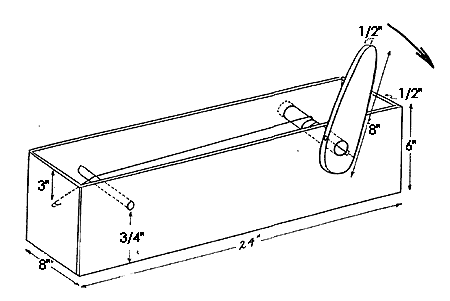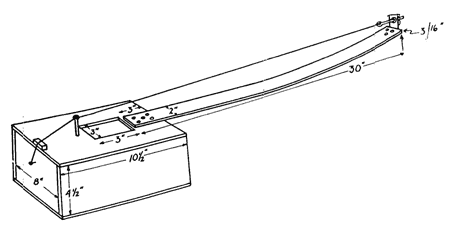


Here are two projects from the book Radio and Television Sound Effects, written in the early 1950's by Robert B. Turnbull. The book is long since out of print, and, in fact, my local library no longer has a copy. The book included construction articles for many devices used in making sound effects. Two of the most interesting were the "Boing Box" and the "Twang Box ", which are presented here, word for word, as they were in the original book.
This is the device that makes the comedy sound, "Twaaaannngggg."

Build a wooden box to the dimensions given. At one end insert a 1/2 to 3/4 -inch (12-19 mm) piece of pipe and anchor it firmly to the sides of the box. At the other end use a piece of 1-in. (25 mm) wooden dowel rod. Fasten a wooden handle to the rod as shown in the drawing. This rod must be able to rotate freely. At the end of the box the farthest distance from the rod and handle, attach a piece of 10-guage 0.024-in. (.06 mm) diameter tinned music wire so that it is anchored slightly below the metal rod that runs across the box. Run the wire to the 1-in. rod (with handle) and wrap it a couple of turns around the rod, then fasten that end of the wire securely to the dowel rod.
To use, pull the handle in the direction of the heavy arrow just enough to take up the slack in the wire. With the free hand pluck the wire, then instantly jerk the handle back and forth so as to alternately release and tighten the tension on the wire.
A little practice will show just how much tension on the wire and how much pull on the handle will give the desired effect. The boing box gives a similar effect except that usually the tone of the sound is higher and the instrument can be worked faster.
The top of the twang box is open, there being no cover on it.

The chief components of the boing box are the resonating body, steel wire, and flexible neck.
Construct the box to the dimensions given using well-seasoned 1/2-in. (12.7 mm) wood, except the face which should be made of 1/4-in. (6.35 mm) three-ply. The box should be accurately cut and fitted, and fastened together with countersunk flat-head screws.
Cut a 3-in. (76 mm) square hole in the top surface of the box. The upright screw eye (bridge) should be about 2 1/2 or 3 in. (63-76 mm) long and solidly screwed into the top about an inch from the sounding hole. The 30-in. (762 mm) flexible neck should be made of 3/16 in. (4.76 mm) plywood, 2 in. (50 mm) wide. or of the same dimension flexible metal. Securely bolt one end of the neck to the sounding box.
At the other end of the neck bolt a 2-in. (50 mm) right-angle bracket. Pass an eye bolt through the projecting part of the angle iron, and secure at the outside with a lock washer and wing nut.
The wire should be 10-gauge .024-in. (.6 mm) diameter tinned music wire. The Johnson Steel and Wire Company manufactures a satisfactory wire in 25-ft. lengths that sells for thirty cents which may be obtained in most hardware stores. Attach the wire to the screw eye on the side of the box, run up over the top edge of the box, through the upright screw eye, and fasten to the eye bolt. Tighten the wing nut until the tension on the wire definitely bows the neck of the instrument.
To get the "boing", pluck the tautened wire and shake the box vigorously so the neck vibrates. A little practice will show how tight to draw the wire and how rapidly to vibrate the box.
This article was printed from the Bizarre Labs website at bizarrelabs.com